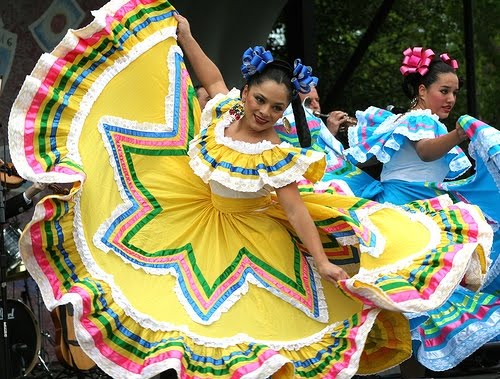•Preference for earth-like
colors, like brown or dark
red, although it is not
uncommon to find vivid greens and strong yellows as part of the clothes’ colors.
•Traditional Mexican clothing combines native and European elements. The fibers
of choice among the Mexicans are cotton, bark and agave (which were known and used by native Mexican
pre-Hispanic civilizations to make their clothes), as well as wooland silk (introduced by
the Spanish later).
•Typical
women clothing includes a skirt, a “huipil” (a kind of sleeve-less tunic), a “quechquémitl” (a closed shoulder
cape) and a “rebozo”
(a kind of shawl).
•Mexican clothing for
men is mostly “European-like”, which means that both the trousers and the shirt
are European garments, and possibly the only native addition to the men’s
wardrobe is a large blanket cape, called “Sarape”. Men often wear Mexican boots too.
•During the Carnival, the Mexican
clothing of choice is the “Charro” suit, popularized by the famous musical ensembles
known as the Mariachis.
•Commonly
used coins in circulation nowadays are: 50¢, $1, $2, $5, $10; the rarely used
coins are: 5¢, 10¢, 20¢, $20, $50, $100.
•Traditional
Mexican foods include tortillas, beans, rice, chicken, beef and goat based
dishes, avocado, papaya, corn and etc.
A Few Dance Moves I've Tried Practicing
http://youtu.be/EUxFducYXyk
My Article Research
The article discusses
how cultural values may impact the learning experience for a Hispanic American
child. Hispanic Americans
are united through customs, language, religion and values.
Characteristics of Hispanic Students
•Family
commitment
•Loyalty
•A
strong support system
•Child’s
behavior reflects on the honor of the family
•Hierarchical
order of siblings
•Discomfort
with classroom competition
•Importance
of respect for authority
•The
male is perceived as dominant and strong
•The
female is perceived as nurturing and self sacrificing
How I Can Play A Role As A Teacher
•Be
aware of cultural group characteristics and self image problems
•They
have customs, values, and educational orientation
•Allow
the school to provide Spanish-speaking teachers, counselors, and educational
assistants
•Pay
attention to identity formation and individuation because it is challenging and
problematic for them
•Focus
on the strengths of each individual
•Plan
interventions
•Group
counseling with peers or even parents call on pastoral counseling
•Match
instructional resources and methods to individual environmental, emotional,
physiological and psychological preferences
The Type of Environment They May Prefer
1.A cool environment
2.Conformity
3.Peer oriented
learning
4.Kinesthetic
instructional resources
5.A high degree of
structure
6.Late morning and
afternoon peak energy levels
7.Variety of opposed
routines
8.A field dependent
cognitive style
How Hispanic Students Differ From Anglo Students in the Learning Environment
•Numbers of
generations in the United States
•Behavioral styles
•Individualism
•More inclined to
picking up their parents beliefs, preferences and lifestyles
•Hispanic males become
independent sooner
•Lower self esteem
•Anglos prefer
learning alone and eating or drinking snacks while learning
Anglos are also are
more auditory and visual


































